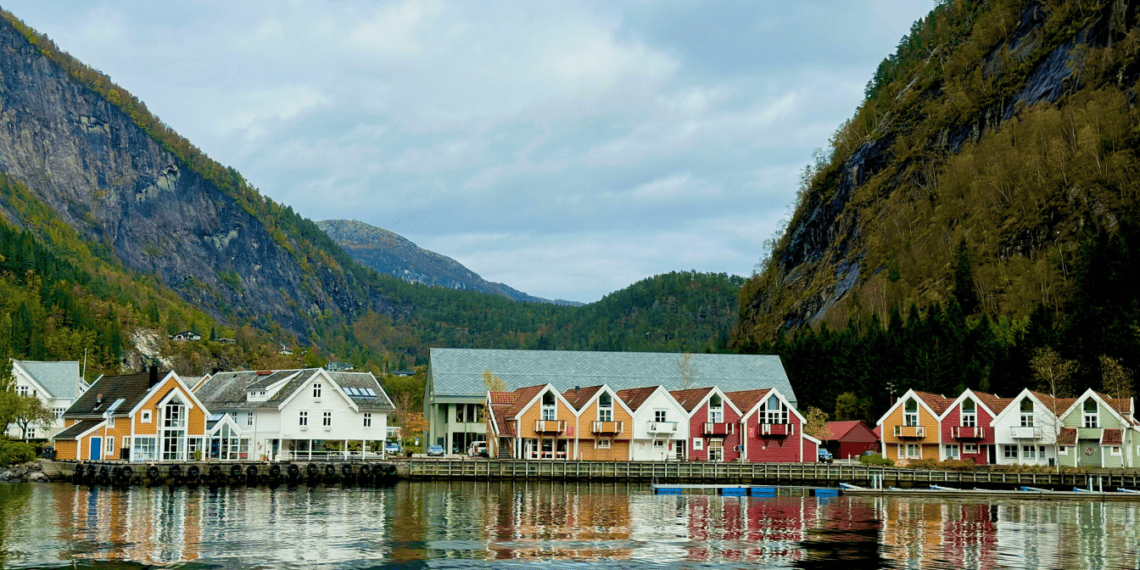Have you ever dreamed of stepping into a real-life fairytale? Imagine quaint hamlets and charming villages on lush, rolling hills. Europe’s countryside is full of these magical places, each one more beautiful than the last. From sunny historic towns in the Mediterranean to misty landscapes in the British Isles, these hidden spots are waiting for you.
Exploring these hidden gems, I was amazed by the variety of beauty. Each village had its own special character, shaped by history and nature. Some, like the colorful fishing villages in Italy, were full of life. Others, like the stone cottages in the English Cotswolds, seemed timeless, offering a peaceful break from today’s world.
Getting to some of these places takes a bit of work. They’re often in remote spots, only reachable by winding roads or trails. But the journey is worth it! You’ll see stunning views and feel a sense of adventure you won’t find in cities.
Key Takeaways
- Europe’s countryside is full of charming villages and quaint hamlets that feel like a fairytale.
- These places show off a mix of beauty and history, with landscapes that take your breath away.
- You can find hidden gems all over Europe, each with its own special vibe.
- Some villages are lively, while others offer a quiet escape from the hustle and bustle.
- Getting to these places might take some effort, but the trip is part of the adventure.
Discovering Hidden Gems in Europe's Rural Landscapes
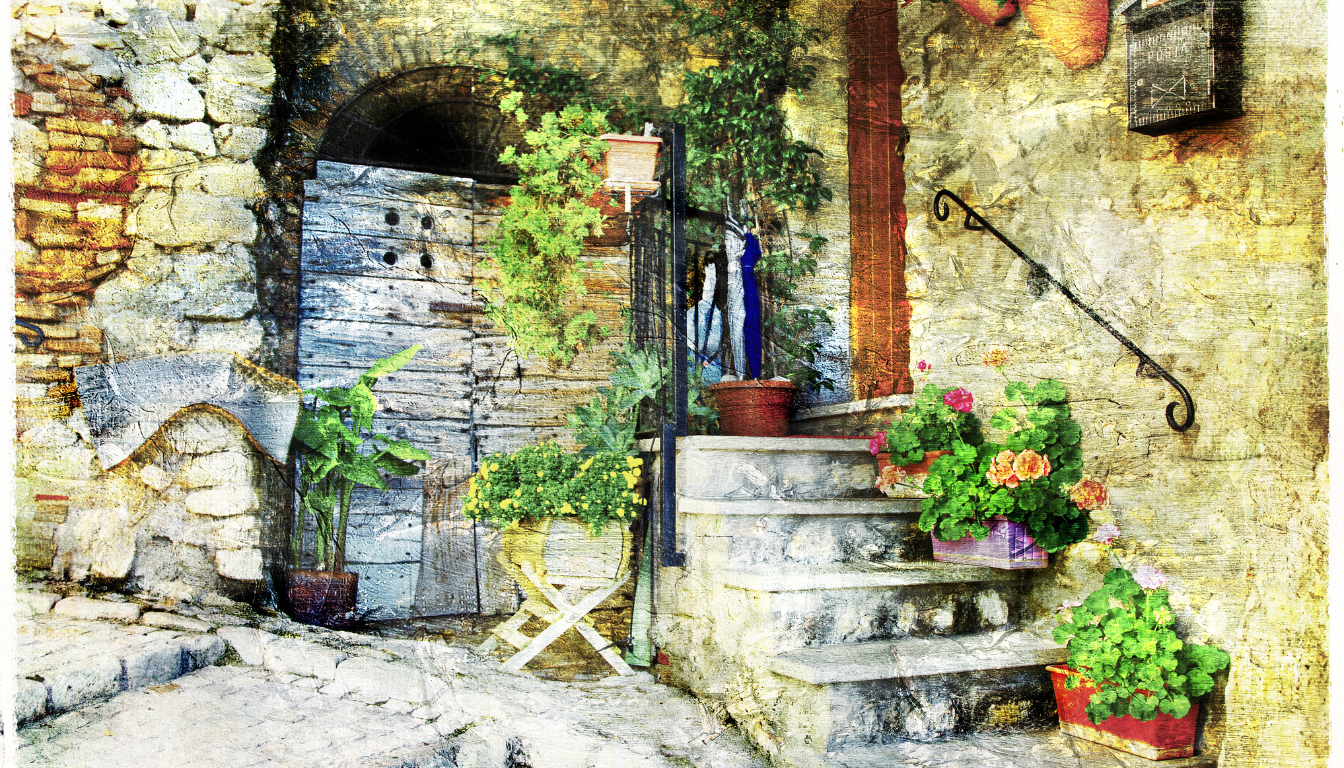
European Best Destinations lists 18 hidden spots for 2025, picked by over a million travelers from 172 countries. You can find everything from colorful houses in Villajoyosa, Spain, to untouched beaches in Primosten, Croatia. These places offer a mix of rural peace and real local culture.
| Hidden Gem | Country | Key Attraction |
|---|---|---|
| Ares del Maestre | Spain | Panoramic views and centuries of Spanish history |
| Lake Bokodi | Hungary | Floating chalets and serene atmosphere |
| Naantali | Finland | Colorful seaside town and Moomin theme park |
| Bour | Faroe Islands | Rustic charm and panoramic ocean views |
| Blavand | Denmark | Coastal dunes, windswept beaches, and transformed wartime bunkers |
Other hidden gems include Dartlo, Georgia, a remote village in the Caucasus with untouched nature and ancient towers. Cicmany in Slovakia shows off hand-painted houses and folk art. And Pont-en-Royans in France is a cliffside village with stunning views and clear rivers for swimming.
Whether it’s a lakeside hamlet in Austria or a hauntingly beautiful village in Romania, these storybook towns are the stuff European dreams are made of.
Exploring these hidden villages lets travelers dive into Europe’s rural beauty. It’s a chance to make lasting memories and truly experience local culture and traditions.
When I visited Telč in the Vysočina region of the Czech Republic, I was amazed by its beauty and architecture. This town is a UNESCO World Heritage Site since 1992. It’s known for its stunning Renaissance and Baroque buildings.
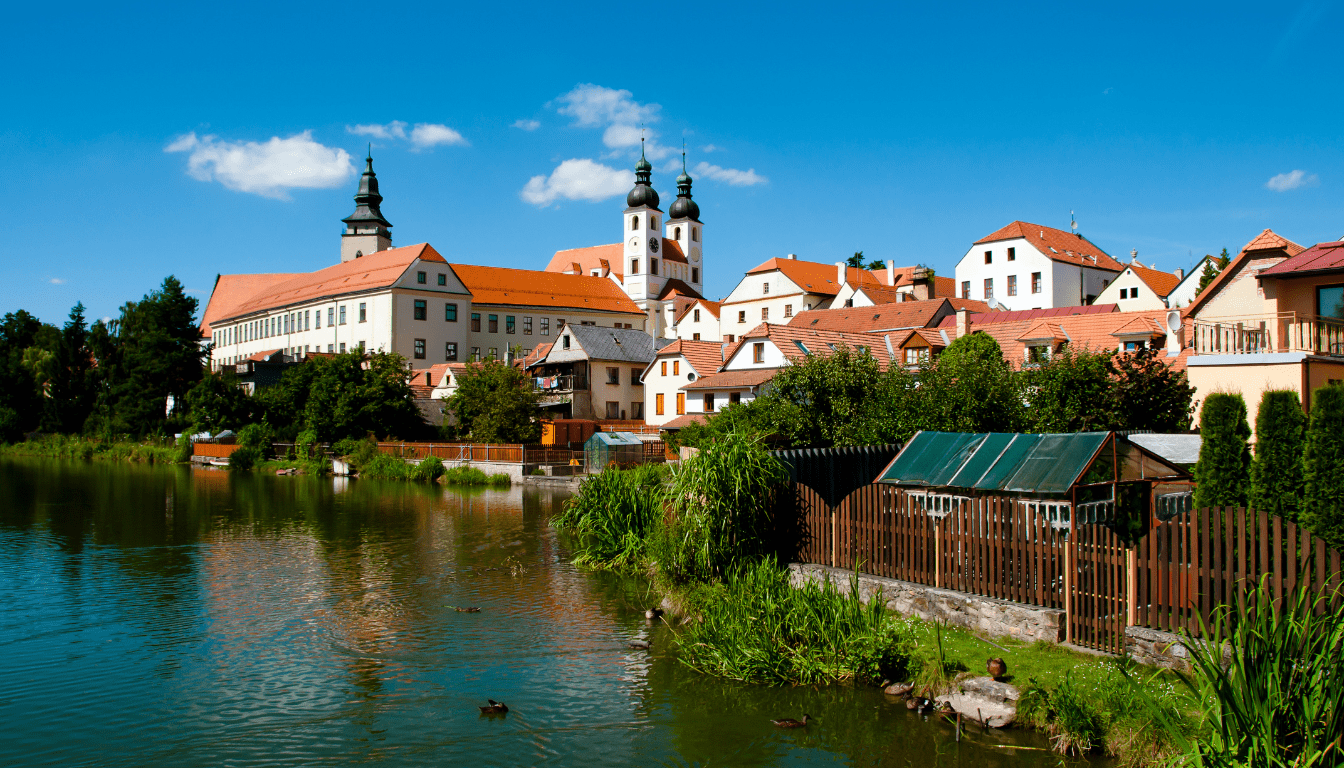
People call Telč the “Czech Florence” because it looks a lot like the Italian city. The town faced two big fires, in 1386 and 1530, which destroyed many homes. But the people rebuilt their homes, trying to make the most beautiful facade.
The Picturesque Main Square Lined with Colorful Facades
This friendly competition led to a main square with some of Europe’s most beautiful Renaissance and Baroque buildings. The houses have unique colors like yellow, pink, and green. They now have shops and cafes, inviting visitors to explore.
The main square of Telč is like a living canvas, where every brush stroke is a beautifully crafted facade, telling the story of the town’s rich history and the pride of its residents.
The town is also known for its large ponds around the main square. These ponds add to the town’s charm and remind us of its past as a key trade center.
Exploring the Grandeur of Telč Castle
At the end of the square, Telč Castle stands tall. It’s a Renaissance-era castle that started as a Gothic structure in the 14th century. In 1550, it was expanded and became a grand home for the nobility.
The castle is a masterpiece of Moravian Renaissance architecture. Its original interiors are still well-preserved. Visitors can see the castle’s grandeur and learn about Telč’s noble past.
| Telč Castle Facts | Details |
|---|---|
| Original Structure | Gothic castle built in the second half of the 14th century |
| Renaissance Renovation | Expanded and renovated in 1550 |
| Notable Resident | Zachariáš of Hradce, leading Moravian nobility |
| Architectural Style | Gem of Moravian Renaissance architecture |
| Interior Preservation | Original interiors preserved in very good condition |
Exploring the underground passageways beneath the Town Square was amazing. It showed me the rich history and architectural beauty of Telč. This small town is a hidden treasure that should be seen by everyone who loves beauty, history, and Renaissance and Baroque architecture.
Bibury is a gem in South-West England’s Cotswolds, known for its charm. It’s a medieval village with honey-colored cottages and green meadows. It’s so beautiful, it draws over 1.4 million visitors every year, even though it’s small with only 600 people.
Walking through Bibury felt like stepping back in time. The village is far from the nearest train station, adding to its secluded feel. Yet, its beauty makes it a top spot for tourists, showing its huge potential in tourism.
Arlington Row: A Timeless Lane of Sepia-Hued Cottages
Arlington Row is Bibury’s star attraction. It’s a lane filled with cottages from the 14th century. These cottages were for weavers and later became homes in the 17th century. They’re now part of a conservation area, keeping Bibury’s history alive.
For those dreaming of living in a historic Cotswold cottage, Bibury has a special option. You can stay in Cottage number 9 along Arlington Row. It’s a chance to experience life in a timeless village and connect with rural England.
Trout Fishing in the River Coln
The River Coln runs through Bibury and is famous for its trout fishing. The Bibury Trout Farm is a top spot for fishing, loved by many. Walking by the river, I saw the clear water and trout swimming below.
| Attraction | Description |
|---|---|
| Arlington Row | A picturesque lane of 14th-century weavers’ cottages |
| Bibury Trout Farm | A popular spot for trout fishing, ranked #2 on TripAdvisor |
| River Coln | A pristine waterway that flows through the village center |
Bibury may not have many places to eat and drink, but its beauty makes up for it. You can see the whole village in just a few hours. It’s a perfect spot for a quick, memorable break from city life.
Visitors to Bibury should respect the local people and the village’s beauty. By doing so, we can keep Bibury’s charm for future generations.
When I arrived in Hallstatt, Austria, I was swept away by its magical charm. This lakeside village in the Austrian Alps is a treasure. It beautifully combines alpine beauty with a deep salt mining history.

The view of Hallstatt by the Hallstätter See is stunning. The lake mirrors the mountains, creating a scene that feels like a fairytale. The village’s buildings, covered in ivy, and its architecture add to its timeless beauty. This is why Hallstatt was named a UNESCO World Heritage Site in 1997.
“Hallstatt’s combination of lakeside location, alpine beauty, and well-preserved architecture makes it a true gem in the Austrian Alps, captivating visitors with its timeless charm and breathtaking mountain views.”
Walking through the market square, I was amazed by Hallstatt’s history. The village has been mining salt for an incredible 7,000 years. This long tradition has greatly influenced the village’s success and culture.
| Attraction | Key Information |
|---|---|
| Hallstatt Salt Mine | Open year-round, except for a 4-week closure from mid-Jan to mid-Feb |
| Beinhaus (Bone House) in St. Michael’s Church | Houses over 1,200 painted skulls, with more than 600 sorted by family; entrance fee: €12 |
| Salzbergbahn funicular to the ‘World Heritage Skywalk’ | Ticket price: €22 per person |
Despite its small size, Hallstatt is packed with things to do. Visitors can explore the ancient salt mine or see the unique skulls in the Beinhaus. And don’t miss the stunning mountain views from the ‘World Heritage Skywalk’ on the Salzbergbahn funicular.
However, Hallstatt’s popularity has led to some issues with over-tourism. It gets over 10,000 visitors a day in the busy season. But its charm and beauty still make it a top spot for those looking for a magical escape in the Austrian Alps.
In the heart of the Cyclades Islands, Folegandros Greece is a hidden paradise. It’s a small island with only 750 people living there all year. This makes it a perfect place to escape the crowds of big cities.
Walking through Folegandros, I fell in love with its beauty. The streets are paved with slate and lined with buildings painted white. They’re covered in bright flowers. You’ll see blue-domed churches that show the island’s strong Orthodox faith.
Folegandros is a place where time seems to stand still, inviting visitors to immerse themselves in the simple joys of life.
Folegandros is full of charm and adventure, even though it’s small. The island has beautiful beaches with different things to do at each one:
- Katergo Beach: A secluded stretch of pebbly shore accessible only by foot or boat
- Agali Beach: A popular spot with crystal-clear waters and a handful of tavernas
- Livadaki Beach: A quiet haven perfect for snorkeling and relaxation
Katergo Beach: A Secluded Stretch of Pebbly Shore
Katergo Beach is perfect for a quiet swim. You have to walk 1.5 miles from the main town to get there. When you arrive, you’ll find a beautiful cove with emerald waves and pebbly shore. It’s a peaceful place away from the crowds.
| Ferry Route | Duration | Frequency | One-way Economy Ticket |
|---|---|---|---|
| Piraeus to Folegandros (regular ferry) | 10 hours | 3-4 times per week | ~50 euros |
| Piraeus to Folegandros (high-speed ferry, April-October) | 5 hours | Weekly | ~85 euros |
| Inter-Cycladic route (Syros, Paros, Naxos, Ios, Sikinos, Kimolos, Milos) | Varies | Twice per week | Varies |
Leaving Folegandros, I felt grateful for the chance to visit this unspoiled gem. This small island in the Cyclades touched my heart with its beauty, friendly people, and adventures. I can’t wait to go back and explore more of this enchanting place.
In the Alsace region of northeastern France, Colmar is a charming village. It blends French and German influences beautifully. This town, between the Rhine River and the Vosges Mountains, has a history dating back to the 9th century.

Walking through Colmar, I was amazed by its half-timbered houses. The city’s architecture shows a mix of Teutonic and Gallic styles. Places like St. Martin’s Church and the Pfister House show off the town’s rich history.
Exploring the Cobblestone Lanes and Quiet Canals
Exploring Colmar’s cobblestone lanes and canals is a must. The Krutenau district, known as “Little Venice,” is especially beautiful. It has colorful houses and flower bridges. I joined a private walking tour for a closer look at the town’s hidden spots.
Our guide spoke French, German, and English and made the tour interesting. They told us about Colmar’s history and why it was saved during World War II. The city’s beauty was a reason it was spared.
Savoring Local Specialties: Foie Gras and Choucroute
Trying local foods in Colmar is a must. Alsace is known for its food, and Colmar is a key part of that. You can find delicious foie gras and choucroute garnie, a mix of sauerkraut, sausages, and pork.
| Dish | Description |
|---|---|
| Foie Gras | A luxurious delicacy made from the liver of fattened ducks or geese, often served as a terrine or pâté. |
| Choucroute Garnie | A traditional Alsatian dish featuring sauerkraut, various sausages, pork, and sometimes potatoes. |
| Kugelhopf | A sweet, yeasted cake flavored with almonds and raisins, baked in a distinctive circular mold. |
| Alsatian Wines | The region is renowned for its crisp Rieslings, aromatic Gewürztraminers, and elegant Pinot Noirs. |
“In Alsace, we have the best of both worlds – the finesse of French cuisine and the heartiness of German fare. It’s a culinary paradise!”– Chef Jean-Pierre, a local restaurateur
Enjoying a warm croissant and kugelhopf cake, I loved how Colmar blends French and German food. The town’s food scene shows its unique culture, inviting visitors to taste history.
In the stunning Lofoten archipelago, the village of Reine, Norway lies above the Arctic Circle. Since 1743, it has been key for trading fish like cod and stockfish. Even after the Germans burned part of it down in 1941, Reine kept its charm as a true Nordic wilderness spot.
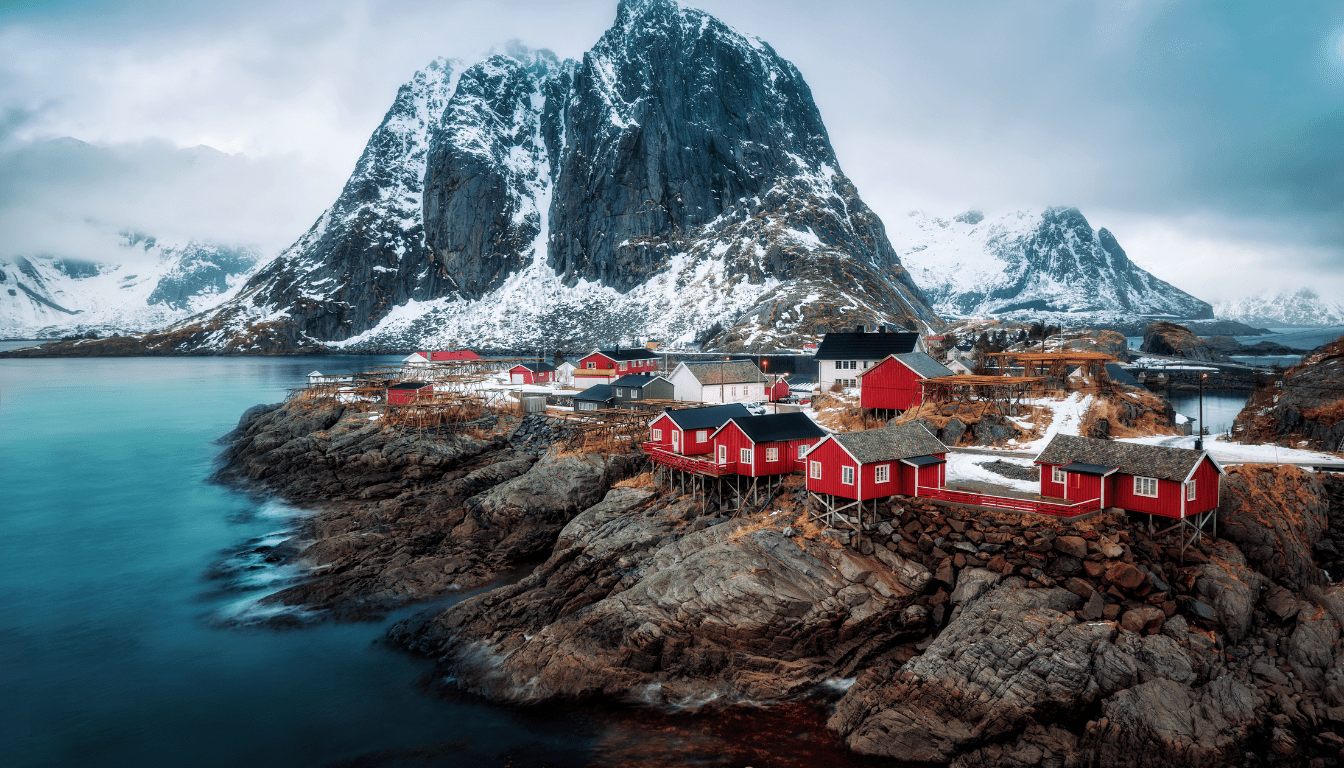
The village is a feast for the eyes, with sapphire bays and fjords meeting mountains. Visitors can dive into the breathtaking scenery and stay in traditional fishermen’s cabins, or rorbuer. These cabins, once for fishermen, now welcome travelers with comfort.
Reine is almost as far west as you can get in Lofoten, with a 2-hour drive from Svolvær city.
Today’s rorbuer in Lofoten come with many comforts, including:
- Private bathrooms
- Comfortable beds
- Fully-equipped kitchens
- Fireplaces
- Saunas
- Jacuzzis
Reine is home to three of Lofoten’s most stunning rorbuer spots:
| Location | Island | Notable Feature |
|---|---|---|
| Eliassen Rorbuer | Hamnoy Island | Iconic photo spot |
| Sakrisøy Rorbuer | Sakrisøy Island | Picturesque setting |
| Reine Village | Reine Island | Olstinden mountain backdrop |
These places offer a direct view of the Norwegian Sea. They’re perfect for seeing the midnight sun in summer or the northern lights in winter. Reine’s beauty has inspired artists and appeared in movies like Disney’s Frozen.
With its deep history, stunning views, and unique stays, Reine is a must-see for those wanting to explore the Arctic Circle. It’s a place where the beauty of the Lofoten archipelago comes alive.
In central Aragon, the village of Albarracín is a treasure from medieval Spain. Walking through its narrow alleys, I felt like I was back in time. The ancient stone towers, ocher-hued castles, and chapels told stories of the past.
The village’s architecture is stunning, with historic walls protecting it. The Sierra de Albarracín mountains add to its timeless beauty.

Following the Historic Walls to the Old Moorish Castle
Exploring Albarracín’s historic walls was a highlight. These ancient fortifications amazed me with their skill and strength. They have stood for centuries.
The walls took me to the old Moorish castle on a hill. The view from the top was incredible, showing Albarracín and the countryside. The castle, though ruined, still shows the grandeur of Moorish times.
| Feature | Description |
|---|---|
| Location | Situated on a cliff in Aragon, central Spain |
| Architecture | Well-preserved medieval architecture |
| Fortifications | Surrounded by historic walls and an old Moorish castle |
| Landscape | Nestled within the Sierra de Albarracín mountain range |
Walking back through Albarracín, I felt awe and respect for its history. This medieval village touched my heart. Its beauty will always be in my memory.
“Albarracín is a journey through time, where every stone tells a story and every corner holds a secret. It’s a place that reminds us of the enduring power of history and the importance of preserving our cultural heritage.”
If you’re in Spain, don’t miss Albarracín. It’s a treasure that shows Spain’s rich history. It’s perfect for those who love the beauty of the past.
Pučišća Croatia is a hidden gem on the island of Brac. It charms visitors with its true beauty and authentic feel. The village is known for its white stone villas, terracotta roofs, and narrow alleys. The main square is a beautiful stone-paved spot that’s the village’s heart.
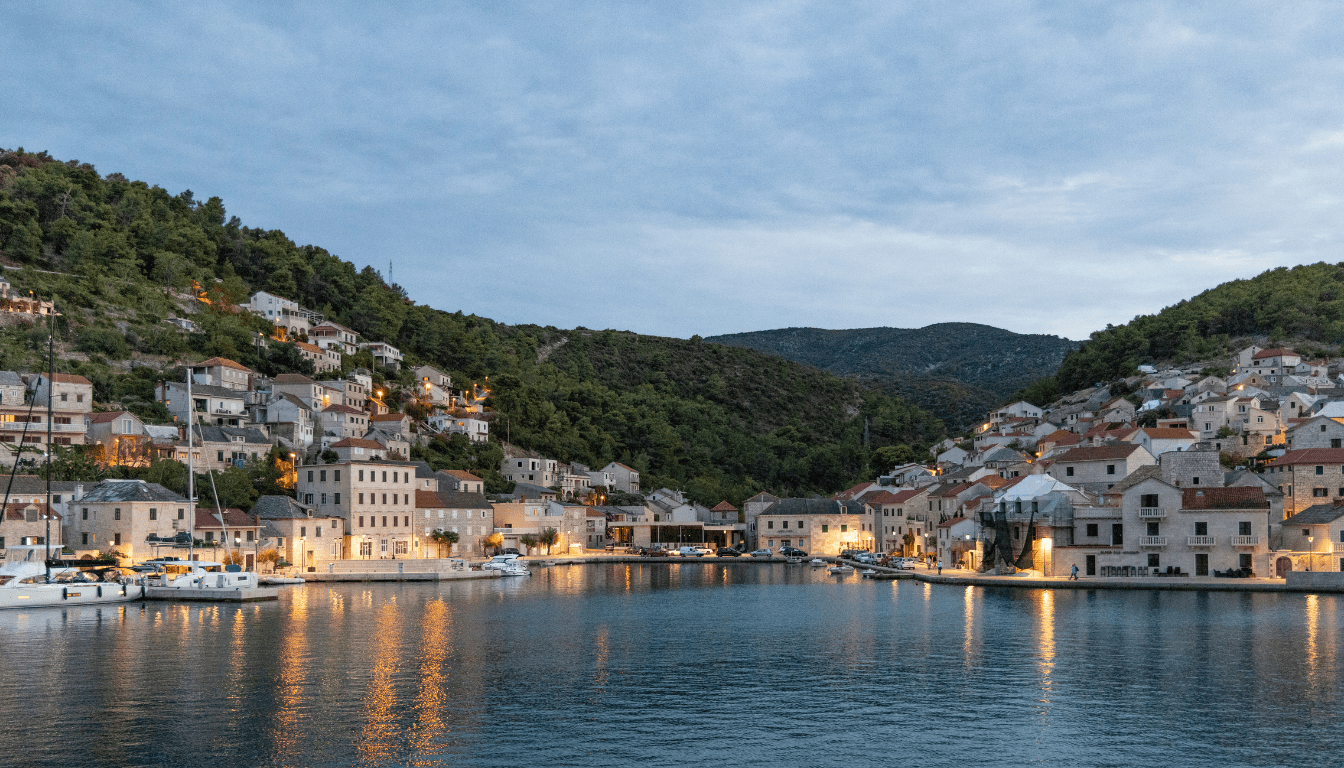
Pučišća is famous for its stone carving tradition. The Klesarska Skola, a stone carving school since 1909, uses local limestone. The village shows off the skills of these artisans with sculptures, lamp posts, and stone houses.
Visitors find many things to do in Pučišća. The village’s charm grows with the stone carving school’s exhibitions and shops. Outside, the beaches and coves offer clear waters perfect for swimming away from the crowds.
Pučišća is a true gem on the island of Brac, and we invite travelers to explore its unique beauty and offerings. – The Ferryhopper team
For adventure lovers, Pučišća has a lot to offer:
- Cycling through beautiful countryside
- Scuba diving in the Adriatic’s clear waters
- Water-skiing on the calm sea
Food enthusiasts will love the traditional Dalmatian dishes in the village. Many restaurants serve delicious lamb dishes that highlight the area’s food heritage.
| Season | Temperature | Months |
|---|---|---|
| Summer | Up to 35°C | June to September |
| Spring | 20-25°C | March to June |
| Winter | Mild (peak in February) | December to February |
Pučišća is a hidden haven with stunning architecture, a rich culture, and untouched nature. It offers an authentic Croatian experience by the Dalmatian coast. Come and make memories in this enchanting village.
The village of Cong sits on the border of County Mayo and County Galway. It’s a mix of history and nature. I found it enchanting. With only 175 people, it’s smaller than some towns but has a big heart.
Picture-perfect landscapes and ancient stone bridges are everywhere. They lead to a medieval abbey ruins. Walking through, I felt the monks’ presence. The village has quaint cottages with thatched roofs, adding to its charm.
Exploring the Ruins of the Medieval Abbey
Visiting the medieval abbey was a highlight. Founded in the 12th century, it was key to the area’s history. I imagined the monks’ lives as I walked through.
“The abbey’s serene atmosphere and rich history make it a must-see for any visitor to Cong.”
For more on the abbey, consider a guided tour. Guides share fascinating stories about the monks.
Admiring the Grandeur of Ashford Castle
Ashford Castle is another must-see. This 13th-century estate became a luxury resort hotel during the Victorian era. It shows Ireland’s history and aristocracy.
Walking through its gardens and by Lough Corrib, I felt amazed. Staying here offers a royal experience in Ireland’s history.
| Village | County | Population |
|---|---|---|
| Cong | Mayo/Galway | 175 |
| Inis Oírr | Galway (Aran Islands) | 281 |
| Kilmore Quay | Wexford | 372 |
Cong is easy to get to from Irish cities. It’s near Galway City, Dublin, and Cork airports. Public transport connects it to Galway and Westport, making it accessible to all.
Cong is full of history, beauty, and Irish hospitality. Whether you’re exploring ruins, admiring Ashford Castle, or enjoying the village, it will touch your heart.
The medieval hamlet of Gruyères, Switzerland, is a dream for cheese lovers. It sits in the upper valley of the Saane River. This village, with its 2,000 residents, is famous for Gruyère cheese, a Swiss staple for centuries.

Walking up to the 13th-century Gruyères Castle, I felt like I was in another time. The castle’s big walls and views of the Alps made the place magical.
Savoring the Famous Gruyère Cheese
Trying the famous Gruyère cheese was a highlight of my visit. This mild, nutty cheese is key in Swiss dishes like fondue. It’s made with Gruyère and Emmental cheeses.
I visited a local cheese factory to learn how Gruyère is made. Oliver, a cheesemaker with 20 years of experience, showed me the process. The milk is boiled for 20 hours. The factory had a tasting board with eight types of Gruyère, each aged differently.
| Aging Time | Flavor Profile |
|---|---|
| 6 months | Mild |
| 8 months | Medium |
| 10 months | Strong |
To learn more about Gruyère, I went on a dairy farm tour at 6:00 AM. I saw how cows, which live for 12 to 20 years, make this cheese. The Alps’ green grass makes the milk for Gruyère special.
Visiting the Imposing Gruyères Castle
Then, I visited the famous Gruyères Castle. This 13th-century fortress shows the area’s history and culture. It has big walls and amazing Alpine views.
Exploring the castle, I was amazed by its long history. It has watched over Gruyères for centuries.
The village of Gruyères is full of things to do. It has small inns, restaurants, galleries, shops, and a chocolate maker. These places help the local economy thrive.
Leaving Gruyères, I appreciated the hard work in making Gruyère cheese. I also admired the village’s effort to keep its culture alive while looking to the future.
At the foot of the Julian Alps lies the magical town of Bled, Slovenia. It’s a place that has won the hearts of many with its stunning beauty and a touch of fairy tale magic. The main attraction is the famous Lake Bled, a glacial lake that shines in beautiful blue and green colors.

Walking around Lake Bled brings peace and calm. There are no motorboats on the lake, so you can only hear the sound of the water. The path takes you from the town to villages and a campground, perfect for walking or just enjoying the view.
On the lake’s island is a small church, the Church of the Assumption. This island church is a beautiful spot with Baroque architecture and a rich history. Visitors can take a boat to the island to see it up close.
As I sit on a veranda overlooking the lake, sipping on a chilled blueberry liquor, a traditional Slovenian drink, I am filled with a sense of pure contentment. The fairy tale setting of Bled, Slovenia, has truly cast its spell on me.
High above the lake, the hilltop castle, Bledski Grad, stands tall. This 11th-century castle tells the story of the area’s history. Inside, you can see old frescoes and learn about the castle’s past at the museum.
Trying the kremsnita pastry is a must in Bled, Slovenia. This sweet treat is filled with custard and cream, topped with sugar. It’s a perfect way to end a day exploring the alpine town.
| Activity | Description |
|---|---|
| Hiking | Embark on breathtaking hikes in the Julian Alps, with trails ranging from 4 to 6 hours and distances between 5 to 7 miles. |
| Canyoneering | Explore the hidden canyons and waterfalls of the region, experiencing a thrilling adventure in the heart of nature. |
| Cycling | Discover the scenic beauty of Bled and its surroundings on two wheels, pedaling along picturesque trails and roads. |
| Swimming | Take a refreshing dip in the crystal-clear waters of Lake Bled or venture to nearby Lake Bohinj for a more secluded swimming experience. |
Bled, Slovenia, is a true treasure in the Julian Alps. It offers a fairy tale setting that touches everyone’s heart. With its beautiful Lake Bled, charming island church, and stunning hilltop castle, it’s a place you must visit for its beauty, peace, and magic.
As I walked through the big walls of Óbidos, Portugal, I felt like I was in a magical medieval village. This town sits on a hilltop near the west coast of Portugal. It’s full of whitewashed houses covered in bright bougainvillea. The streets are made of cobblestones, leading you to hidden spots in this timeless place.
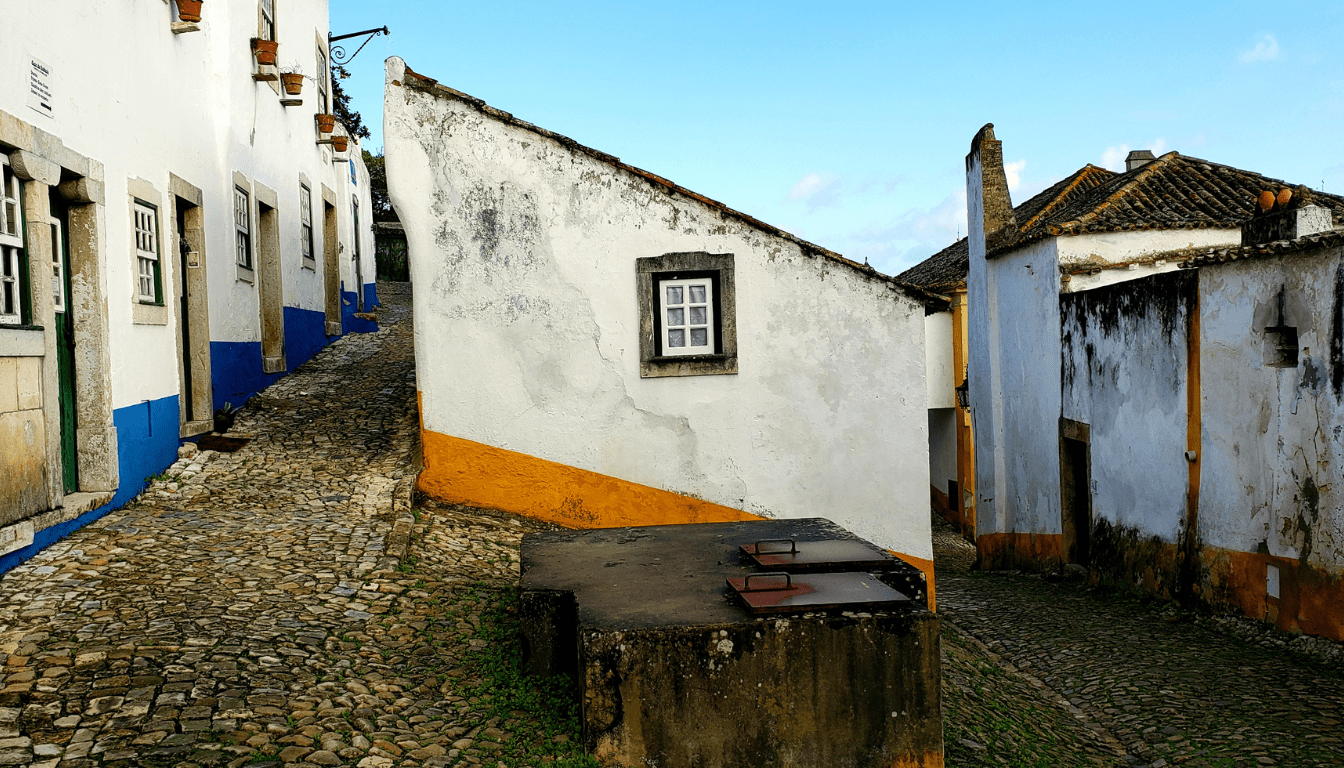
For centuries, Óbidos has been a favorite spot for visitors, even royalty since the 13th century. Today, it still amazes people who come through its strong walls. Even with lots of tourists, the town keeps its real charm. Staying overnight lets you enjoy quiet evenings and mornings, really taking in the beauty of the village.
Óbidos has a long history, over 2,000 years. Many cultures, like the Celts, Romans, Visigoths, and Moors, have left their mark. The castle, which dates back to Roman times, was later made bigger by Portuguese kings. It now has Portugal’s first state-run inn. In 2015, Óbidos was named a UNESCO Creative City of Literature because of its historic buildings that are now bookstores.
“Wandering through the cobbled streets of Óbidos feels like stepping into a fairy tale. The whitewashed homes adorned with bougainvillea and the private gardens create a picturesque atmosphere that captivates the imagination.”
Walking through the narrow streets, I loved the colorful buildings and how the sunlight made them glow. The village is famous for its ginjinha, a sweet liquor made from sour cherries. Drinking this while enjoying the medieval sights was unforgettable.
| Attraction | Description |
|---|---|
| Óbidos Castle | Dating back to Roman times and enlarged by Portuguese kings, now houses Portugal’s first state-run inn |
| Whitewashed Villas | Charming homes adorned with vibrant bougainvillea, creating a picturesque atmosphere |
| Cobblestone Walkways | Winding paths through the medieval village, inviting visitors to explore |
| Ginjinha Liquor | A sweet, local liquor made from sour cherries, perfect for sipping while taking in the surroundings |
Óbidos is a captivating place with its well-kept medieval charm and beautiful views. Whether you’re walking the cobblestone paths, looking at the whitewashed houses, or enjoying a glass of ginjinha, this town in Portugal will leave a lasting impression.
Guarda, Switzerland: A Remote Alpine Village with Unique Charm
Guarda is a hidden gem in the Lower Engadine region. It’s surrounded by stunning mountains and green meadows. The village’s beauty and traditions caught my attention right away.
The village is famous for its decorated houses. These designs show the area’s rich culture. Walking through the village, I was amazed by the skill in these decorations.
Admiring the Traditional Painted and Carved House Decorations
The decorations on the houses in Guarda are a sight to see. They feature religious scenes and floral patterns. The carved decorations are also impressive, showing the talent of local artisans.
“The painted and carved house decorations in Guarda are a true feast for the eyes. They transform the village into a living work of art, where every building has its own unique character and charm.” – Local resident
Listening for the Rare Romansh Language
I tried to listen for the Romansh language in Guarda. It’s a rare language spoken here. Hearing it was special, showing me a unique culture.
| Village | Population | Unique Features |
|---|---|---|
| Guarda | Not specified | Painted and carved house decorations, Romansh language |
| Wengen | 1,300 (permanent), 5,000 (summer), 10,000 (winter) | Year-round activities, popular ski race venue |
| Morcote | 771 | Rich history and culture, remarkable architectural wonders |
Guarda is a hidden gem with a unique look and culture. Saying goodbye, I felt grateful for the beauty and traditions here. It’s a place that shows the beauty of the world’s hidden spots.
In the southeastern corner of Malta, Marsaxlokk is a charming fishing village. The moment I arrived, I was drawn to the vibrant colors of the traditional boats, called luzzijiet, in the harbor. These boats, with their unique painted eyes, reflect the village’s deep fishing roots.
Marsaxlokk is famous for its fresh seafood. The luzzijiet boats bring in tuna, swordfish, and lampuki every day. The smell of grilled fish fills the air, inviting visitors to try the seafood at the harbor’s restaurants. A visit on a Sunday morning is best for the bustling fish market.
Walking through Marsaxlokk, I saw the mix of Mediterranean cultures that shape Malta’s food and culture. Its location near Italy has blended European, Arab, and North African traditions. This is seen in the village’s architecture and the flavors of its food.
Marsaxlokk is not just a place; it’s a vivid representation of Malta’s rich history and the resilience of its people, who have thrived on the bounties of the sea for generations.
Close to the village, I found St. Peter’s Pool. This hidden cove is loved by locals for swimming and sunbathing. The clear waters offered a peaceful escape from the village’s lively vibe.
| Attraction | Description |
|---|---|
| Marsaxlokk Harbor | A picturesque harbor filled with colorful traditional fishing boats called luzzijiet |
| Sunday Fish Market | A bustling market showcasing the freshest catches from the village’s fishermen |
| Seafood Restaurants | Numerous restaurants serving delectable seafood dishes, including tuna, swordfish, and lampuki |
| St. Peter’s Pool | A secluded limestone cove with crystal-clear waters, perfect for swimming and cliff jumping |
Marsaxlokk is a great place to start exploring Malta’s sights. It’s close to UNESCO temples, the ancient city of Mdina, and Gozo’s cliffs. Marsaxlokk offers a real taste of Maltese life, with its friendly people and beautiful spots.
Giethoorn is a village in the Netherlands known as “The Venice of the North.” It’s famous for its many canals and no cars. Over a million people visit each year, even though it’s home to less than 2,800 people.
When I arrived, I felt the peace and beauty of the place. People move around by boat, walking, or biking. This lets visitors enjoy the calm. Boating is key to experiencing Giethoorn, as you see beautiful houses and gardens along the canals.
Navigating the Village by Boat through Miles of Canals
Boating in Giethoorn is a joy. The village has 176 bridges, offering stunning views at every turn. The sound of water and leaves adds to the peaceful journey.
For those who like walking, there’s a 9.5-mile path through the village and countryside. It’s perfect for walkers and bikers, thanks to the car-free streets and bridges.
| Activity | Description |
|---|---|
| Boating | Rent a boat and explore the canals, passing under wooden bridges and admiring the thatched-roof farmhouses |
| Walking | Embark on the 9.5-mile walking route through the village and countryside, enjoying the tranquil surroundings |
| Cycling | Cycle along the car-free paths, crossing picturesque bridges and discovering hidden corners of the village |
Ice Skating on Frozen Canals in Winter
Giethoorn is magical in winter, when the canals freeze over. Visitors can ice skate, passing by snow-covered roofs. It’s a beautiful sight to see people enjoying this Dutch tradition.
Skating on the frozen canals of Giethoorn was like stepping into a fairy tale. The crisp winter air, the sound of blades on the ice, and the picturesque surroundings made for an unforgettable experience.
Giethoorn has more than just canals and pretty buildings. It has museums like the Museum Giethoorn ‘t Olde Maat Uus and the Museum de Oude Aarde. For food lovers, Restaurant 141 and De Eetkamer van Giethoorn are great spots with amazing views.
Giethoorn feels timeless and peaceful. Its canals, bridges, and thatched houses show a simpler life. Whether by boat in summer or ice skating in winter, Giethoorn shows Dutch charm and the beauty of nature.
Conclusion
Exploring Europe’s charming villages and countryside has been magical. From Telč’s colorful Renaissance buildings to Óbidos’s whitewashed houses, each place has its own charm. These hidden spots show off Europe’s deep history, culture, and traditions.
Visiting these villages lets you enjoy things like Switzerland’s famous Gruyère cheese or the calm canals of Giethoorn in the Netherlands. You can also see the stunning Matterhorn in Zermatt. These places offer a break from busy city life.
They encourage you to slow down and live like the locals. You’ll learn to appreciate the beauty of the countryside. I feel grateful for my time in these villages. The locals’ kindness, the beauty, and the charm of these places have touched my heart deeply.
I hope others will explore Europe’s charming villages too. These hidden gems are waiting for you. The memories you make there will stay with you forever.
FAQ
What are some of the most charming villages in Europe?
Europe is home to many charming villages. Telč in the Czech Republic and Bibury in England are two examples. Hallstatt in Austria and Folegandros in Greece are also must-sees. Colmar in France, Reine in Norway, and Albarracín in Spain are favorites too.
Don’t forget about Pučišća in Croatia, Cong in Ireland, and Gruyères in Switzerland. Bled in Slovenia, Óbidos in Portugal, and Guarda in Switzerland are also top picks. Marsaxlokk in Malta and Giethoorn in the Netherlands round out the list. These villages are known for their beauty, history, and local culture.
What makes a European village picturesque and charming?
European villages are charming because of their stunning nature and historic buildings. You’ll see colorful facades, cobblestone streets, and traditional architecture. They also have a strong local culture.
Visitors can explore quaint shops, cafes, and markets. These places give a peek into the local way of life.
Are these charming European villages easy to reach?
Some villages like Hallstatt in Austria and Bled in Slovenia are easy to get to. They’re popular and have good tourist facilities. But, places like Folegandros in Greece or Guarda in Switzerland might be harder to reach.
They’re in remote spots and have fewer transport options. The journey to these hidden spots adds to their charm and keeps them authentic.
What are some activities to enjoy in these picturesque villages?
In these villages, you can explore the local history and culture. Take a walk through the narrow streets and enjoy the architecture. Many offer tours of historic sites like castles or abbeys.
Outdoor lovers can hike, fish, or swim in the beautiful landscapes. Food enthusiasts can try local dishes at small restaurants or markets.
When is the best time to visit these European villages?
The best time to visit depends on what you like and where you’re going. Summer is popular with nice weather and long days, but it’s also busier and pricier.
Spring and fall are great for fewer crowds and mild weather. Winter can be magical in places like Hallstatt or Bled with snow and festive traditions. But, some places might close during winter.
Are there any hidden gems among these European villages that are particularly worth seeking out?
Yes, some villages are perfect for those looking for something different. Folegandros in Greece and Pučišća in Croatia offer a peek into local life away from the crowds. Guarda in Switzerland is another hidden treasure.
Marsaxlokk in Malta and Giethoorn in the Netherlands are unique too. They have colorful fishing boats and canals, offering a special experience.





















